FROM THE EDITORS...
There is just something about New York City in the spring: the sights, sounds, smells, and especially, the people. Walk down any avenue, at any time of the day or even night, and you will hear an exotic polyglot of languages as you experience multiple levels of intersecting realities. The life of the city never stops. It is a city of the imagination, for the imaginative, and New York City’s cultural heritage is certainly international, more so than any other major urban venue. In this space and time of renewal in the post-September 11 era, is there a better location than the “new” New York City to conduct an international conference in film studies? After all, New York City has a long established, unique relationship with the history and business of film production, and New York City’s presence in so many international and national film narratives, from the silent era right up to the present, attests to its prominence as a locus classicus.

Statue of Liberty, New York
On May 5th and 6th of 2006, the “International Conference on Realism and Naturalism in Film Studies” was held at the Graduate Center of the City University of New York, jointly sponsored by the AIZEN and the CUNY Graduate Center, Film Studies Certificate Program (FSCP). Since 1999, The Graduate Center’s vibrant campus has been housed in a nine-story landmark building on Fifth Avenue in the tony district of midtown Manhattan. Formerly home to the B. Altman Department Store, the building has been redesigned as a new, state-of-the-art facility to meet the specific needs of a twenty-first-century institution of advanced learning. In the street-level lobby you can move easily to the art gallery, the recital hall, the library, the auditorium, and the lower-level conference center. The middle of the building houses the academic programs and research centers. The dining room is another grand space, on the top floor, with the skylight giving the feeling that you are really at the top and that the City is all around, present. Transformed into the Graduate Center of the City University of New York, this historic building is now the intellectual focal point of progressive academics in New York City.
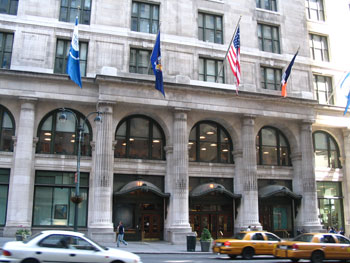
CUNY Graduate Center in Manhattan
The 2006 joint AIZEN/CUNY conference was unique for all concerned, since its focus was Film Studies. The papers presented were of great interest to specialists in the field and, in particular, to all wishing to explore cinematic realism and naturalism. Concurrent sessions were scheduled during the two days of the conference, with three, four, or five speakers participating in each one. Papers on realism and naturalism in film featured works by filmmakers not only from the U.S., but also from France, Russia, Denmark, Germany, and Belgium. Several presentations discussed films with a clear connection to Zolian naturalism, beginning with the era of silent film and moving through the twentieth century. Various aspects of realist representation were addressed, such as aesthetics, adaptations of realist or naturalist novels, and the reference to milieu and social issues. Open to the public and to all students, this conference was attended by an especially international group, more than fifty participants from the U.S., Canada, Israel, Denmark, the United Kingdom, Russia, Portugal, Belgium, and France. Furthermore, our association, thanks to its dynamism and vision, has done much to assure the continuation of high quality research in the area of naturalism and has thereby brought into the spotlight a number of talented young researchers. To this conference in NewYork, we welcomed graduate students from the best North American universities. A big thank you, therefore, to all participants, for their contribution to the intellectual content and international character of the event.
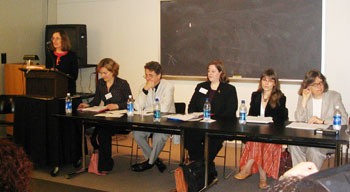
Session on Naturalist Foundations. From left: Carolyn Snipes-Hoyt, Katherine Siân Griffiths, Roy Chandler Caldwell, Jennifer Wolter, Agnieszka Tworek, and Laurel Cummins
Several special panels were organized for this conference: the first, on contemporary realism and naturalism in French and Belgian-Walloon cinema, under the direction of Anna Gural-Migdal, took place in French. Thank you to Vicente Rodriguez Ortega for organizing a panel entitled “Re- Imaginings of the Real in Film,” in which connections between realist cinema and the documentary were explored. Hats off to Delia Caporoso Konzett and Marsha Orgeron who respectively organized the panels on “Cinematic Orientalism,” and on “Disruptive Realisms: Four Directors.” Finally we are grateful to Sylvie Richards for putting together the panel “Zola and the City.”
We were especially thrilled to welcome as an honored guest an eminent specialist in Zola and Naturalism, David Baguley, an Emeritus Professor of both the University of Western Ontario (Canada) and the University of Durham (UK). Professor Baguley has authored numerous books in the areas of Zola and Naturalist Studies, notably Naturalist Fiction: The Entropic Vision (Cambridge University Press, 1990 and 2005) and Le Naturalisme et ses genres (Nathan, 1995). He also edited the two volumes of bibliography for critical work on Emile Zola (University of Toronto Press, 1976 and 1982). In recent decades, he has played a major role in linking Zola and Naturalist Studies in French- and English-speaking areas on both sides of the Atlantic. His professional engagements testify to this adaptability: he has served as President of the Emile Zola Society, based in London, England, and is a member of the research team of the Centre for Research on Zola and Naturalism, at the University of Toronto.
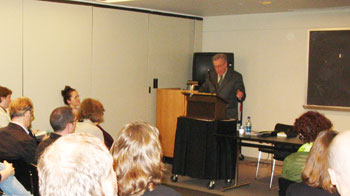
Guest Speaker: David Baguley
The title of David Baguley’s talk was “Riduttore, traditore? On Screening Zola.” A longer recast version of this paper was published in Volume XXI of Excavatio (2006) as part of the section “Screening Naturalism: Problematics of Film Adaptation.” To open this section, David Baguley takes up the debate concerning the poetics of film adaptation and, in particular, the question of “word” versus “image.” Baguley shows that the transformation of a novel into a film brings along with it generic issues that are inherent in the principle of adaptation. Following this line of argument, he offers an analysis of the two best-known film versions of Zola’s Nana, by Christian-Jaque (1955) and by Jean Renoir (1926), as well as a recent version, with a strong pornographic dimension: Nana, The True Key of Pleasure (1982) by Dan Wolman.
The Comfort Inn Manhattan, where the conference-goers were lodged, boasted accessibility, amenities, and value with the ambiance of a small European hotel. Participants could easily meet and relax together in the lobby. The Midtown location offered convenience for everybody, as it is within walking distance to the Fashion District, Macy’s, Fifth Avenue shopping, the Empire State Building, Madison Square Garden, Rockefeller Center, St. Patrick’s Cathedral, Times Square, Radio City Music Hall, and the Javits Center. As part of the program of social and cultural activities arranged for this conference, a cocktail party took place early Friday evening at Brendan’s Bar and Grill, located next to the Comfort Inn Hotel. All participants were happy to meet for drinks and conversation.

Hotel Exterior
Later that night, in one of the CUNY Graduate Center’s beautiful auditoriums, the Segal Theatre, a special film was screened for the Film Festival: Detour (1945), directed by Edgar Ulmer and starring Tom Neal and Ann Savage (USA, 69 minutes; in black and white, English version). Made on a low budget and in just one week, this classic American film noir, seedy and desperate, tends toward naturalism and social commentary. Sometimes also labeled a film gris, due to its unremitting bleakness and its all-too-average characters, Detour is set between the limitless dives and dumps found from New York to L.A., following the adventures of a down-and-out nightclub pianist hitchhiking from L.A. who is picked up by an amiable gambler. When the driver dies of a heart attack, the pianist takes his wallet and dumps the body; but when he picks up a woman on the road, he finds himself in trouble because of her suspicions and reckless nature. After seeing this film, the viewer will never pick up a hitchhiker again!
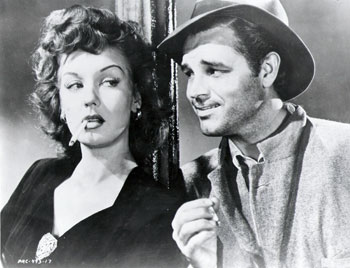
Ann Savage and Tom Neal in Detour
On Saturday evening, a “naturalist dinner” à la new yorkaise was organized at John’s. Nearly one hundred years old, this beautiful restaurant is a NewYork legend, located in Greenwich Village. It is frequented by well-known New York artists, including the actors from the Sopranos series. Participants enjoyed a friendly atmosphere and partook of Italian specialties such us Bruschetta, Chicken parmigiana, Penne with broccoli rabe and Sun Dried Tomatoes, or Ragu with Broad Noodles, and the incontournable Tartuffo for dessert. Glass after glass of Cabernet and Chablis were served at the table. If the goal of this international conference was to bring together the most original and critically significant research in the interrelated areas of realist and naturalist film studies, then many conference-goers raised a glass of wine that night to celebrate this achievement.
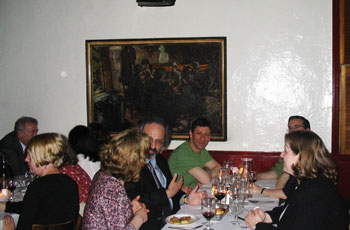
Naturalist Dinner. From left: Steven Amarnick, Robert Singer, Katherine Siân Griffiths, Jennifer Wolter, and Frank Percaccio
Any individual who has been involved with the creation and presentation of a conference, especially one that brings scholars from both international and national locations to a major urban site, knows how involved the planning and execution of events will be. The organizers of the AIZEN/CUNYjoint International Conference on Realism and Naturalismin Film Studies, Robert Singer, Organizer-in-Chief and Vice President of the AIZEN, and Anna Gural-Migdal, Co-Organizer and President of the AIZEN, would like to thank all the individuals who contributed to the success of this event. Thank you to Prof. William Boddy, coordinator of the Film Studies Certificate Program at the CUNY Graduate Center for his strong support and his introductory talk, as a special guest, on the interrelated areas of film studies and theory; Prof. William Coleman, executive officer of the Comparative Literature Department at the CUNY Graduate Center for his generous support of the conference; and all of the support services and offices located at the CUNY Graduate Center that contributed to the overall success of the conference. A special acknowledgment goes to Mary Frisque, Assistant Program Officer, Certificate Programs, at the CUNY Graduate Center, for her patience and good humor during the more frenetic days.
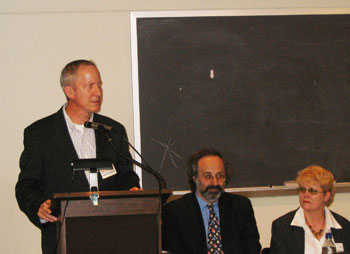
Opening Speeches. From left: William Boddy, Robert Singer, and Anna Gural-Migdal
Additional names must be cited for the completion of the arduous tasks of planning and executing some of the more overwhelming conference-related events, both anticipated and unforeseen. Prof. Diane Smith, SUNY Farmingdale, served as an adviser to the conference and especially helped us throughout the entire project. In particular, Prof. Frank Percaccio, Kingsborough, CUNY, worked tirelessly as the assistant organizer of the conference and proved his patience, humor, and courage on multiple occasions; and Monica Filimon, in the Comparative Literature Ph.D. Program at Rutgers University, served as an assistant conference coordinator and must be acknowledged for her extraordinary on-site efforts at the conference. Many thanks also go to Prof. Carolyn Snipes-Hoyt, secretary-treasurer of the AIZEN, who provided the usual thoughtful and hard-working support for which we all identify her as a standard-bearer. Some more recent additions to the AIZEN group, Alexandra Miekus and Romain Chareyron, both of whom are graduate students in the University of Alberta, were a solid supportive presence at the conference and provided their generous help from the beginning to the end.
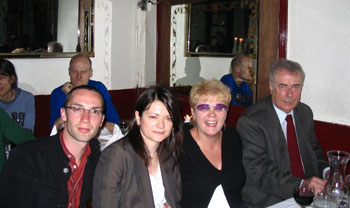
Naturalist Dinner. From left: Romain Chareyron, Alexandra Miekus, Anna Gural-Migdal, and David Baguley
Indeed, this is the second time that the AIZEN has selected New York City as a conference site. What a good idea since the conference was overall a huge success! This confirms that the city of New York, in spite of the fact that it had been cruelly challenged in 2001, has nevertheless the ability to surmount difficulties thanks to its incredible energy. This is certainly the reason why the “Big Apple” will always remain one of the most vibrant urban centers in the world, from cultural and intellectual perspectives.
The AIZEN and the Department of Finnish Language and Literature, University of Helsinki, are proud to announce a unique conference-collaboration, to be held on August 14 and 15, 2008, at the University of Helsinki in Finland. The University of Helsinki was established in Turku in 1640 and transferred to Helsinki after the Great Fire of Turku in 1827, when Tsar Nicholas I ordered the Royal Academy of Turku be moved to the new capital city of the Grand Duchy of Finland, Helsinki, where the Imperial Alexander University of Finland began to operate the next year. This university (38,806 students) has the widest range of disciplines in Finland! The Department of Finnish language and literature at the University of Helsinki is the largest teaching and research unit of its kind in the world. The primary scholarly interest of its Finnish Literature program is the history and evolution of Finnish literature. The Department emphasizes the study and research of historical contexts and intertextual connections alike, and looks beyond national to international literature. The Finnish Literature has a strong profile as a unit specializing in Finnish literary history, and within this domain in particular in genre research, genre history and period related concepts of literature.
The 2008 AIZEN/University of Helsinki joint international colloquium will be something new since we have selected as a conference theme “Woman under Construction. Female Representations in 19th-Century French and Scandinavian Realism and Naturalism.” The representation of the female figure in realist and naturalist literature, highly developed in France and Scandinavia by the end of the 19th century, remained exceptionally ambiguous: naturalist literature is most typically obsessed by the catastrophic images of female sexuality and the myth of the fallen woman; but, in Scandinavian countries, for instance, female figures served as a means to reveal the misery and injustice suffered by women and promote social reform. The literature of the era establishes a space for many often controversial discourses and keeps women continually in a state of construction. Medicalized by scientists and dissected by male authors, woman is excluded from the common social sphere but, at the same time, her representations lay the groundwork for notions of emancipation that promised her access to the centre of society. The objective of this conference is to examine the manifold representations of female figures in Nineteenth-Century French and Scandinavian Fiction.
Sponsored by the Academy of Finland and the Finnish Graduate School of Literary Studies, the conference will be held in the main building of the University of Helsinki at the City Centre Campus next to the Senate Square. The City Centre Campus is the place to be when one wants to enjoy the academic atmosphere rich in tradition. The main building was designed by C. L. Engel, architect, who after the foundation of the Helsinki University was given the assignment of designing an Empire-style main building facing the Imperial Senate.
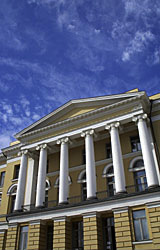
Main building of the University of Helsinki, City Centre Campus
The Senate Square and surrounding buildings form a unique and cohesive example of Neo-Classical architecture. The square is decorated by three buildings also designed by C. L. Engel between 1822 and 1852: the Cathedral, Council of State and the University of Helsinki. In the immediate vicinity you will also find the National Library, "Sofiankatu" street and the Helsinki City Museum, Esplanade Park and Market Square. In the summer Market Square is filled with stalls selling fruits, vegetables, souvenirs, and fresh and smoked fish.
The plenary lectures will be held in lecture hall 10 (3th Floor, S10); for the afternoon sessions we will move to lecture rooms 14 and 15 (4th Floor, S14, S15). The easiest entrance to the lecture halls is by Fabianinkatu 33 (not by the Senate Square - there are two entrances to the main building). All the lecture rooms are equipped with audiovisual equipment, computers, video- and overhead projectors.
As for hotel reservations, all participants are encouraged to lodge in the Hotel Arthur (Vuorikatu 9, 00100 Helsinki; tel.: +358 9 173441, www.hotelarthur.fi). This three-star hotel is only 5 minutes from the University of Helsinki Campus and prices are reasonable (140 € for a double Superior-room). Hotel Arthur is located in the very center of Helsinki, next to Kaisaniemi Park, only one block from Railway Square. The main sights, biggest department stores and theatres are within easy walking distance. Freshly painted and newly renovated, these rooms will make your stay enjoyable. The cosy hotel restaurant is renowned for its cuisine and buffet lunch. The chefs of Restaurant Arthur know how to prepare your meal with heart and soul. Their delicious buffet lunch has already received rave reviews. The à la carte menu offers tasty delicacies for bigger or smaller appetites.
In order to share a room with a colleague you may contact the conference organizers, either Dr. Anna Gural-Migdal (aguralm@ualberta.ca) or Dr. Riikka Rossi (riikka.rossi@helsinki.fi).
To make reservations, please send an e-mail to the following address: reception@hotelarthur.fi
Do not forget to mention “University of Helsinki/Woman under Construction” and to make your reservations before the group reservation cut-off date: June 13, 2008.
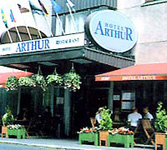
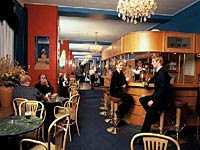
Hotel Arthur, Helsinki
On Thursday evening we will first enjoy a welcome cocktail party in the main building of the university. After the cocktail party we are planning to show Aki Kaurismäki’s silent film Juha (1999) (lecture room 10). The story is based on the Finnish naturalist novel Juha (1911) by Juhani Aho. Aho’s novel, a passionate triangle drama, tells the story of an honest, hardworking settler, handicapped by his ugly physical appearance and lame leg, who loses his young wife, Marja, to a Russian Karelian peddler, Shemeikka. In Kaurismäki’s contemporary version of the settings of 18th-century Eastern Carelia have changed to the modern Finland. Aki Kaurismäki has characterized Juha as “a silent film with music.” There is no spoken dialogue, and the score plays a major role in this extraordinary drama. The emotional state of the characters is mainly expressed through Anssi Tikanmäki's musical score. Another exceptional aspect of Kaurismäki’s film is that this is the first time that most of the scenes take place in a rural setting, and the city represents the forces of evil. Even though Juha is a “silent film,” its style does not imitate that of the silent era of the early 20th century. Instead, it could be described as a modern film implemented in an unusual way. Its visual narrative is contemporary and insightful.
On Friday evening we will enjoy the traditional naturalist dinner (price is included in the conference fee of 80 €) in the restaurant Kappeli (http://www.kappeli.fi/english_chapel.html), located in the centre of Helsinki near the university and the Market Square. Established in 1867, Kappeli is the place where Helsinki's greatest writers, poets, composers, artists, and academics gathered in the evening. According to one story a largish group of artists, composers, writers, and poets, including Juhani Aho, Sibelius, and Gallen-Kallela, was in attendance as usual when Sibelius said he had to go to Stockholm for a couple of days to compose. Participants will be able to have lunch in the university cafeteria for about 5.90 to 6.70 €. There are also many restaurants near the campus, where a fancier meal could be found for about 7 to 10 €.
On Saturday we are planning an excursion to the Hvitträsk (about 30 kilometers outside Helsinki). The lake-side studio home built of timber and stone in the National-Romantic style, by architects Eliel Saarinen, Herman Gesellius, and Armas Lindgren in 1903, is a work of art in itself surrounded by forest and situated on lake Vitträsk. During the early decades, the main building served both as an architectural office and as a cultural home. It was visited by such esteemed figures as Jean Sibelius, Axeli Gallen-Kallela, and Maksim Gorki. The office staff also lived at Hvitträsk, and this is where the plans were drawn up for the Helsinki Railway Station and the National Museum of Finland. Hvitträsk is also the boyhood home for famous architect Eero Saarinen, who made his reputation primarily in the United States designing buildings and monuments such as the Gateway Arch in St. Louis, Missouri. The Saarinen home is a museum today, and within the courtyard building are a restaurant and a café. Hvitträsk and its lovely English style garden are surrounded by natural beauty near the shore of Lake Vitträsk. Please note that the price and the conditions of the excursion depend on the number of participants. If you are interested in the excursion, thank you for e-mailing the local organizer of the conference, Dr. Riikka Rossi (riikka.rossi@helsinki.fi).
Conference-goers will enjoy Helsinki as a modern European cultural city whose urban cosmopolitan lifestyle exists in perfect harmony with nature. Surrounded by the sea and its own exotic archipelago, the capital of Finland offers visitors an endless number of possibilities. Throughout its 450-year history, Helsinki has existed in the crosscurrents of the East and West. The colourful layers of history can be seen everywhere; a walking tour of the city centre or of the magnificent Suomenlinna Maritime Fortress will open your eyes to a fascinating past. Today’s Helsinki is also a city of architecture, cutting-edge design, and state-of-the-art technology. Art lovers will be delighted with Helsinki and its large number of high quality museums and galleries. Life in Helsinki is defined by starkly contrasting seasonal changes. In the summer, the warmth and permanent daylight invigorate the city. The locals worship the sun and welcome the heat with open arms. In August we will have excellent possibilities to enjoy summer weather in Helsinki!

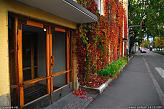
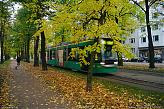
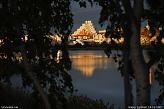
Helsinki, Capital of Finland
(Niklas Sjöblom / taivasalla.net)
We have good news to report about many of our members. Congratulations go to Agnieszka Tworek, who successfully defended her doctoral dissertation, entitled “Prison et théâtralisation,” in 2007, under the supervision of Ora Avni and Donia Mounsef in the Department of French at Yale University. Hats off to Riikka Rossi who also completed her doctorate in 2007, with a thesis entitled “Le naturalisme finlandais. Une conception entropique du quotidien,” under the supervision of Pirjo Lyytikäinen in the Department of Finnish Language and Literature at the University of Helsinki. Riikka Rossi’s doctoral dissertation has already been published as a book (2007) by the Society of Finnish Literature in Helsinki. Congratulations also to Jeremy Worth who was recently hired as an Assistant Professor of French in the Department of Languages, Literatures, and Cultures at the University of Windsor.
We are pleased to announce that Brigitte Émile-Zola, great-grand-daughter of the author we celebrate and a loyal supporter and sponsor of the AIZEN since its inception, has authored a book evoking her earliest memories of Jacques, her grandfather and Zola’s son by Jeanne Rozerot: Mes étés à Brienne, with a préface by Alain Pagès (Éditions du Frisson esthétique, 2008: http://www.frissonesthetique.com/catalogue/etesbrienne.html). In addition to the very personal childhood memories of the author, the volume contains tributes written by others who knew Dr. Jacques Émile-Zola (1891-1963), a selection of family photos, and photocopies of Zola’s handwritten letters to his son. Another bit of unusual publication news for Zola specialists is that Éditions Mouck, a Parisian publisher of children’s books, has come out with an illustrated version of Zola’s early story “Simplice,” from Contes à Ninon (1864). This delightful book features colorful drawings by “Victor” – a talented four-year old.
Other members of the AIZEN have recently produced books. Mihaela Marin published Le livre enterré. Zola et la hantise de l’archaïque (ELLUG, 2007). This work offers a reflection on the cultural space of archaism in the second half of the 19th century. Mihaela Marin’s exploration allows the reader to discover an entire archeology of references – explicit or implicit – that bear witness to the Zolian text’s subtle affinities with the archaic world of Greek tragedy, with a consideration of the procedures of ancient rhetoric, and the collective imagination and its ritual manifestations in certain primitive societies. These are, precisely, the three major directions that structure the composition of the essay.
A book by Maria Watroba, Écritures de l’absence. Essai sur les frères Goncourt, Zola, Proust, Gide, Valéry, Leiris, has come out posthumously with Presses Universitaires de Rennes in 2007. A member of the AIZEN since its beginnings, Maria Watroba, passed away on December 14, 2002, at 41 years of age. From 1987 to 1997, she taught at the University of Yale (USA), where she earned her doctorate in 1993. She prepared her dissertation, entitled “Éros sacré, Éros profane: l’invention du féminin – Freud, Flaubert, Zola, Gide,” under the direction of Denis Hollier. In 1994, she taught at the Université de Genève, in Switzerland. A researcher of great talent, Maria Watroba published a number of essays that have been collected in this volume. Her reflections on the works of a variety of 19th- and 20th-century writers reveal as many variations in “absence” in their writing. In fact, the notion of “absence” appears thus to be the very foundation of writing and provides fuel for all thought on the nature of literature, its goals – and its raison d’être.
Éléonore Reverzy has published a book entitled La chair de l’idée. Poétique de l’allégorie dans Les Rougon-Macquart (Droz, 2007). This work draws attention to the way allegorical structures are put to use in Zola’s novels and render the plots concrete on several levels: for example, history, since “writing” history motivates the analogical forward movement of plot; Zolian philosophy and ethics, which justify the use of a number of procedures for embodying or incorporation; and finally, the representation of artistic creation itself.
Another work, edited by Celina Moreira de Mello and Pedro Paulo Garcia Ferreira Catharina, has been published in Rio de Janeiro, with 7Letras (2006): Crítica e movimentos estéticos. Configurações discursivas do campo literário. This publication is the result of the research group ARS (Art, Reality, Society). This collection presents a study of the polemical aspects of the critical activity of the review L’Artiste, an important periodical for a knowledge of artistic life in the 19th century and the strategies of legitimation for literary movements during that period. We should mention that issues of this review are presently being accessioned and listed by the Bibliothèque nationale de France, on its site Gallica. The years 1831 to 1868 are already available.
Colette Becker has now published Volume 3 of La Fabrique des Rougon-Macquart, Édition des dossiers préparatoires (Champion, 2006), in collaboration with Véronique Lavielle. This volume represents another installment in the publication of the “pre-texts” to accompany Zola’s Rougon-Macquart, with the first edition, in their entirety, of the notes prepared for Une page d’amour, Nana, and Pot-Bouille. This volume deals with novels of Zola’s maturity, works devoted to the representation of woman, her education, her status in society, and her passion. Here, we see Zola constructing plots and characters that he cares about deeply. In addition to revealing the inner workings of his experimental method, these preparatory notes show more of the depth of the personality of the author than the earlier ones. Volume 4 of La Fabriques des Rougon-Macquart will soon appear (Champion, 2008), comprising the pre-texts for Au Bonheur des Dames and La Joie de Vivre. The notes for these two mature works offer answers to the crisis of pessimism Zola experienced following the deaths of Duranty, Flaubert, and his mother, and as a result of extreme physical and mental exhaustion brought on by the insane rhythm of his work. The preparatory notes for Au Bonheur de Dames constitutes a unique document on the birth of department stores in Paris in the second half of the 19th century.
Carolyn Snipes-Hoyt and Anna Gural-Migdal are happy to inform you that they co-edited a collection of essays entitled Zola et le naturalisme en Europe et aux Amériques: Contaminations et influences d’un genre. This volume, which appeared at the end of 2006 with Edwin Mellen Press in New York, comprises sixteen articles by members of the AIZEN, including Kristof Haavik, Mihaela Marin, Linda Toenniessen, Kelly Basilio, Marie-Sophie Armstrong, Robert S. April, Elizabeth Emery, Jurate Kaminskas, Holly Haahr, Ruth Schürch-Halas, Arturo Larcati, Riikka Rossi, Juan Pablo Spicer-Escalante, Ligia Vassallo, Diane Smith, and Robert Singer. The naturalist novel is considered from three angles in this collection: contamination by both other genres and a multitude of social discourses, in addition to its impact outside the Zolian school. These essays will enable readers to move beyond reductive and stereotypical ways of viewing naturalist texts and understand them in relationship to the communities engaged in a dynamic relationship with the narrative power of this genre.
Another piece of good news, this time for Mirbeau specialists: Aleksandra Gruzinska and Anna Gural-Migdal have taken the necessary steps with the RMMLA (Rocky Mountain Modern Language Association) to establish a permanent session on Mirbeau. The session is called “Octave Mirbeau: From Life to Fiction” and its aim is to emphasize all aspects of the life and writing of this novelist and dramatist, whose work deserves to be better known and disseminated in North America. At the next RMMLA conference, which will be held from October 9 to 11, 2008, in Reno, Nevada (USA), four challenging papers will be presented: “Fragments d’une amitié: Octave Mirbeau, Claude Monet et Théodore Robinson,” by Aleksandra Gruzinska; “Horreur et obscénité dans Sébastien Roch,” by Anna Gural-Migdal ; “Une question de famille dans Le Foyer d’Octave Mirbeau,” by Carolyn Snipes-Hoyt; and “De Mirbeau à Genet, la révolte sociale fragmente-t-elle le sujet littéraire?” by Annie Rizk.
Keep in mind that the Société Octave Mirbeau, under the leadership of Pierre Michel, now has its own web site, at the following address: http://www.mirbeau.org/ This web site is an invaluable tool for the development of Mirbeau Studies, since researchers and others who access it will be able to gain knowledge about the life of Mirbeau, his works, and his struggles.
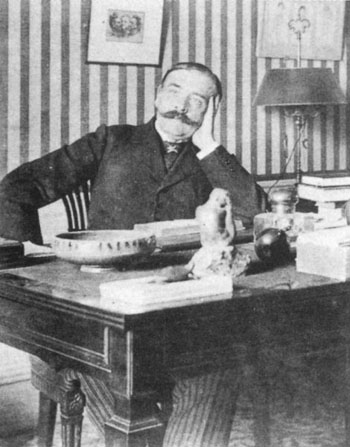
Octave Mirbeau
Volume XXII of Excavatio (2007) is a special issue co-edited by Anna Gural-Migdal and Robert Singer entirely devoted for the first time to “Naturalism and Realism in Film Studies.” This double issue is comprised of twenty-four articles divided into four sections with the following titles: Naturalist Foundations on the Continent; Naturalism and Realism: From Europe to North America; Realism and its Discontents; Naturalism and Realism in Contemporary French-Language Film. We are pleased to inform you that most Canadian universities are now subscribing to Excavatio. Please encourage your university to follow their example and order our most recent issues since our journal is not only an essential tool for scholars who have specialized in the fields of Zola and Naturalism, but also enjoyable reading material and a mine of information for those who are interested in discovering new aspects of works by one of France’s greatest authors.
As editors of this volume XXII of Excavatio devoted entirely to film, Anna Gural-Migdal and Robert Singer would like to thank all the members of the editorial committee, made up of Carolyn Snipes- Hoyt and Marie-Sophie Armstrong, Associate Editors; and Alexandra Miekus, Editorial Assistant. Congratulations to Alexandra, who has given birth (in 2007) to a beautiful little boy named Cohen! Thanks also to Ana Anubis of Ingenieuse Productions for her willingness to replace Alexandra during her maternity leave and take responsibility for the layout of this issue. We would also like to express our profound gratitude to Monica Filimon from Rutgers University for her excellent editorial work on this issue of Excavatio. Thank you to all the authors who contributed to the richness of this volume and were kind enough to recast their papers as a longer version for the requirements of this publication.
Thank you also to the Vice-President of Research at the University of Alberta, Dr. Lorne Babiuk, to the Vice Dean of the Faculty of Arts, Gurston Dacks, as well as to the Associate Dean of Research, Bernard Linsky, for allowing Anna Gural-Migdal to assume fully her duties as Editor-in-Chief of Excavatio, through a reduction in course load. We would also like to express our recognition to Marianne Henn, Acting Chair of the Department of Modern Languages and Cultural Studies, for her support and encouragement during the production of this volume. Finally, on behalf of the entire editorial team, we thank the Social Sciences and Humanities Research Council of Canada for the grant that has made possible the publication of this double volume of the international review Excavatio.
We are proud to announce that Volume XXIII of Excavatio (to appear in 2008) will mainly consist of a selection of the best papers from the AIZEN /University of Helsinki International Conference on “Woman under Construction. Female Representations in 19th-Century French and Scandinavian Realism and Naturalism.” Conference participants are encouraged to submit their papers revised and recast into full-length articles (not less than 4,000 words and no more than 6,000 words including footnotes) for publication in this double issue of our journal. These papers must be formatted in Word, be previously unpublished, and follow the Excavatio “Guide for Authors” (see the AIZEN website for specifications). Submissions should be sent as download files to Anna Gural-Migdal ( aguralm@ualberta.ca) by May 31st, 2008. Eighteen years of existence now for the AIZEN! Do not forget that we need your support and contributions and that our success is also yours! We strongly encourage you to renew your membership if you have not already done so. Annual membership includes, among other advantages, a free subscription to Excavatio. This will be another great year for the AIZEN, since it will be the first time that one of our conference will take place in a Scandinavian country. Need we remind you that Paris was the cultural capital of Scandinavian modernism at the end of the 19th century? Artistic pilgrimages to Paris and exil in this capital resulted in phenomena of “cultural transfer”, according to the theory elaborated by Michel Espagne. In this respect, the example of Strindberg is significant, since he went to Paris to write for a French public and considered his work “naturalist.”
We are looking forward to meeting you in Helsinki and wish you all an excellent holiday!
Anna Gural-Migdal, University of Alberta, andCarolyn Snipes-Hoyt, Pacific Union College,
the 29th of December, 2007.
